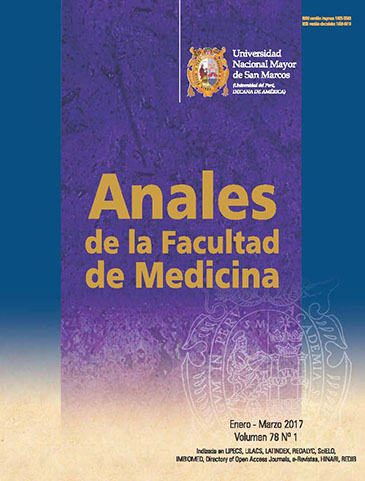Urinary tract infection in renal transplant recipients
DOI:
https://doi.org/10.15381/anales.v78i1.13015Keywords:
Asymptomatic Bacteriuria, Urinary Tract, Pyelonephritis, Renal Transplantation.Abstract
Introduction. Urinary tract infections (UTI) are common among renal transplant recipients (RTR) and their frequency depends on pre- and post-transplant factors. Objectives. To determine the time of appearance of symptomatic UTI among renal transplant recipients, microorganisms causing the infection, and incidence of UTI resistant to antibiotics. Design. Retrospective study. Setting. Renal Transplant Unit, Hospital Edgardo Rebagliati Martins, EsSalud, Lima, Peru. Participants. Patients who have undergone renal transplantation. Interventions. The clinical records of 304 patients subject to kidney transplantation performed between 2002 and 2011 and followed for up to four years were reviewed. There were 215 urine culture-confirmed UTI episodes in 84 transplant recipients. Main outcome measures. Incidence, chronology, microbiological determination/ susceptibility, bacterial resistance, risk factors, diagnostic strategies, presence or absence of bacteremia, and therapeutic management. Results. In 42 of the 84 recipients, the initial episode occurred during the first three months, and 33 (39%) had more than one UTI episode. Bacteria represented the most common etiology (94%), and Escherichia coli was the most prevalent uropathogen, with an extended-spectrum beta-lactamase (ESBL) production rate of 38%, followed by Klebsiella pneumoniae (11%) with an ESBL of 65%. Blood culture was positive in 25 (12%) of the 215 UTI episodes. In 17 recipients (19%), anatomic anomalies of the urinary tract were detected following the transplant. Conclusions. UTI occurred early following kidney transplantation, and Escherichia coli was the most common microorganism found. Antibiotic resistance was present in 79 (37%) of the 215 UTI episodes, representing a continuous challenge in clinical practice.Downloads
Published
2017-05-16
Issue
Section
Artículo Original
License
Copyright (c) 2017 Pedro Méndez Chacón, Fernando Bardales Viguria, Ángel Ardiles Aniceto, Carlos Cervera Álvarez, Carla Méndez Chacón Rodriguez, Armando Vidalón Fernández

This work is licensed under a Creative Commons Attribution-NonCommercial-ShareAlike 4.0 International License.
Those authors who have publications with this magazine accept the following terms:
- Authors will retain their copyrights and guarantee the journal the right of first publication of their work, which will be simultaneously subject to Creative Commons Attribution License that allows third parties to share the work as long as its author and its first publication this magazine are indicated.
- Authors may adopt other non-exclusive licensing agreements for the distribution of the version of the published work (eg, deposit it in an institutional electronic file or publish it in a monographic volume) provided that the initial publication in this magazine is indicated.
- Authors are allowed and recommended to disseminate their work over the Internet (eg: in institutional telematic archives or on their website) before and during the submission process, which It can produce interesting exchanges and increase quotes from the published work. (See El efecto del acceso abierto ).
How to Cite
1.
Méndez Chacón P, Bardales Viguria F, Ardiles Aniceto Ángel, Cervera Álvarez C, Méndez Chacón Rodriguez C, Vidalón Fernández A. Urinary tract infection in renal transplant recipients. An Fac med [Internet]. 2017 May 16 [cited 2025 Jun. 7];78(1):11-6. Available from: https://revistasinvestigacion.unmsm.edu.pe/index.php/anales/article/view/13015



